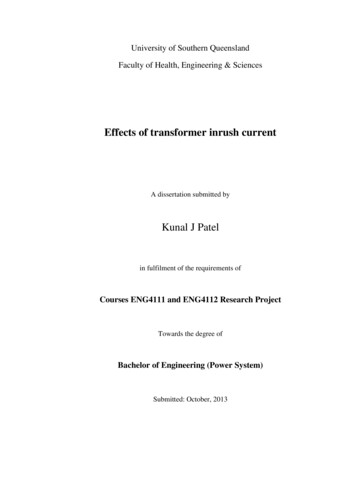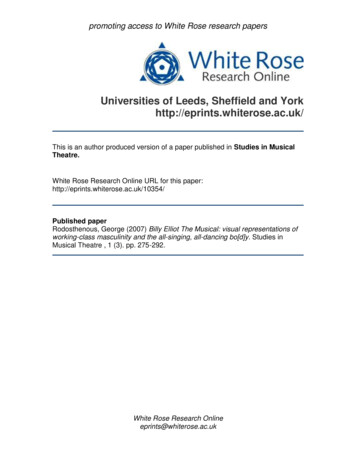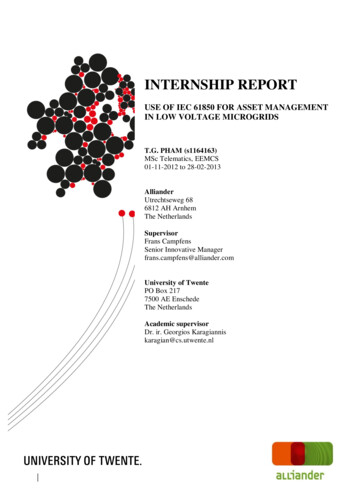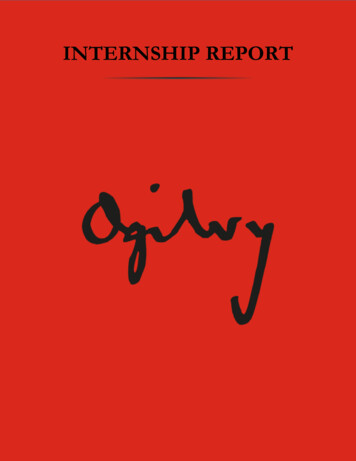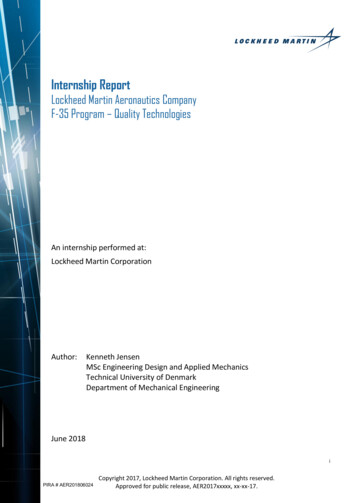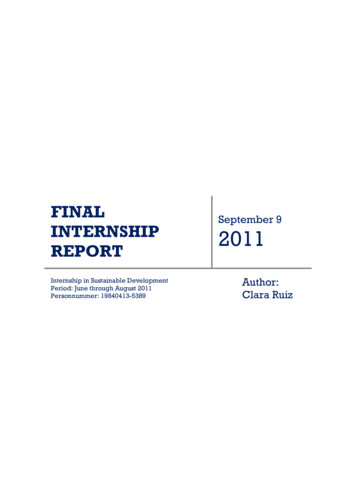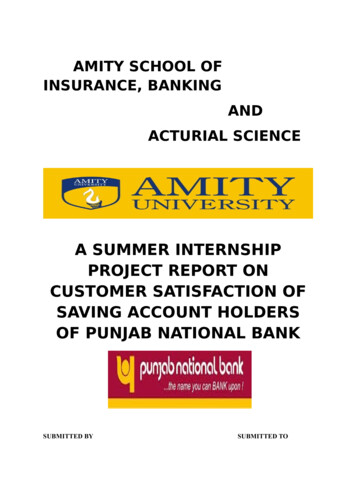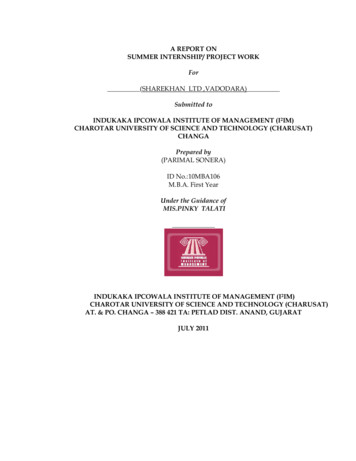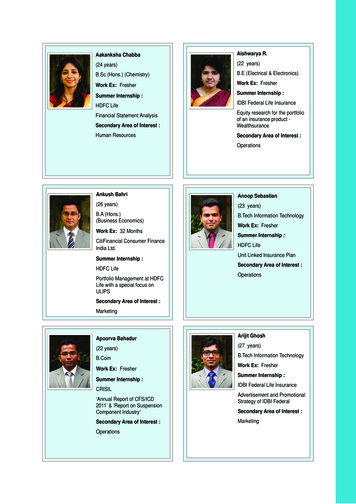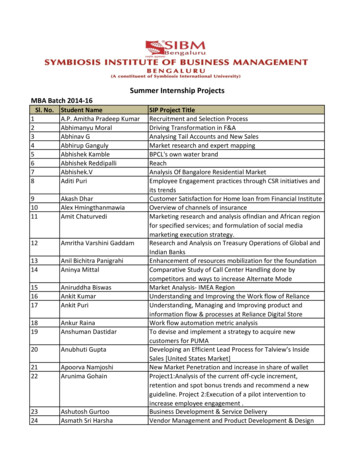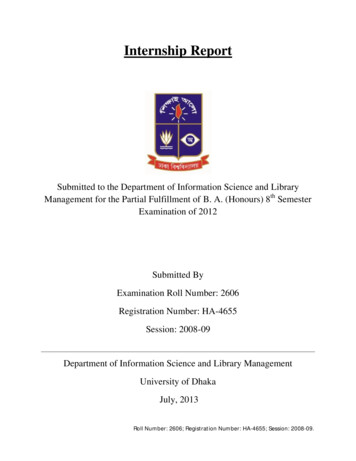
Transcription
Internship ReportSubmitted to the Department of Information Science and LibraryManagement for the Partial Fulfillment of B. A. (Honours) 8th SemesterExamination of 2012Submitted ByExamination Roll Number: 2606Registration Number: HA-4655Session: 2008-09Department of Information Science and Library ManagementUniversity of DhakaJuly, 2013Roll Number: 2606; Registration Number: HA-4655; Session: 2008-09.
Internship Report Submitted to the Department ofInformation Science and Library Management for thePartial Fulfillment of B. A. (Honours) 8th SemesterExamination of 2012Roll Number: 2606; Registration Number: HA-4655; Session: 2008-09.
Internship Report Submitted to the Department ofInformation Science and Library Management for thePartial Fulfillment of B. A. (Honours) 8th SemesterExamination of 2012Submitted ByExamination Roll Number: 2606Registration Number: HA-4655Session: 2008-09Department of Information Science and Library ManagementUniversity of DhakaJuly, 2013Roll Number: 2606; Registration Number: HA-4655; Session: 2008-09.
PrefaceThe main objective of the Internship Report is to fulfill the partial requirements for courseBISLM-428 Internship in Libraries and Information Institutions of the B. A. (Honours) Degreein Information Science and Library Management. It is the output of the one month long (30working days) internship in the Dhaka University Library.An internship is a very good opportunity to gain practical knowledge about any real worldconcept. Internship bridges the theory with the practice in any particular field of study. Thus itclarifies the theoretical concept of the students which may not be possible only through classlectures and follow up examinations. Internship gives the students a clear cut idea about whatthey learnt in the theory and whether these are implemented in the real world situationaccordingly or with modifications. This real life experiences helps the students to make themeligible for the job environment.After the completion of the internship program I have gathered enough experience about theacquisition, processing and dissemination of library reading materials, managerial activities,stock verification, library website, reference services, old manuscript preservation, etc. which Ihave shared in different chapter of the report. There are also some observations from my point ofview which I think would be considerable to the authority for the betterment of the DhakaUniversity Library.Roll Number: 2606; Registration Number: HA-4655; Session: 2008-09.
AcknowledgementI am very much grateful to all the teachers of the Department of Information Science and LibraryManagement; University of Dhaka, for providing me the opportunity to take part into theInternship Programme in the Dhaka University Library under the course BISLM 428 Internshipin Libraries and Information Institutions for the partial fulfillment of B. A. (Honours) 8thsemester examination of 2012. It was a great opportunity for me to have a practical experienceabout the theoretical knowledge that has been disseminated by our meritorious teachersthroughout the four years integrated honours programme.My deep appreciation is extended to the Acting Librarian of Dhaka University Library, ProfessorDr. S. M. Zabed Ahmed, who is also the Chairman of the Department of Information Scienceand Library Management; University of Dhaka, and the other library officers and staffs for theirco-operations, suggestions and guidance to complete the internship programme.I am indebted and thankful to my learned and revered supervisor for his upbeat personality,kindness; encouraging support and willingness to help have tangibly and greatly improve thequality of my Internship Report and brought up to its present status.I owe my deepest gratitude to the authors whose work I have used in this report as I had todepend on different national and international publications for the completion of the internshipreport.Roll Number: 2606; Registration Number: HA-4655; Session: 2008-09.
Table of ContentsPage NumberPrefaceiAcknowledgementiiTable of ContentsiiiList of TablesivList of Figuresv-viList of Abbreviationsvii-viiiChapter – I: Introduction1-10(a)(b)(c)(d)(e)(f)(g)(h)Chapter – IIRationale of the studyObjectives of the studySignificance of the studyScope of the studyMethodologyImplementationLimitations of the studyOrganization of the text: Literature Review and Background11-26Chapter – III : Acquisition Section27-38Chapter – IV : Processing Section39-48Chapter – V49-63: Circulation SectionChapter – VI : Reference Section64-71Chapter – VII : Other Sections72-101Chapter – VIII : Recommendations and Conclusion102-105BibliographyRoll Number: 2606; Registration Number: HA-4655; Session: 2008-09.
List of TablesTable-1: Numbers of Persons Trained by the Certificate and Fulbright CoursesTable-2: Programme Schedule of the InternshipTable-3: Library HoursTable-4: Distribution of Reprography UnitsTable-5: Seat Arrangement in the Reading Room of the Main LibraryTable-6: Library Administration BudgetTable-7: Library Materials Procurement and Maintenance BudgetTable-8: List of the Books Purchased in 2012-13 Session for the Department of InformationScience and Library ManagementTable-9: Statistics of the Processing SectionTable-10: Status of Book Lending Limit, Duration and Fine DetailsTable-11: Kinds of Reference MaterialsTable-12: Amount of Fee for the Issue of Borrowers ID CardTable-13: Charges for Reprographic FacilitiesRoll Number: 2606; Registration Number: HA-4655; Session: 2008-09.
List of FiguresFigure-1: Schematic View of the StudyFigure-2: DUL Main BuildingFigure-3: DUL Science Library BuildingFigure-4: Diagrammatic Presentation of Library PersonnelFigure-5: Flow Chart for Acquisition of Documents in DULFigure-6: InvoiceFigure-7: Barcode LabelFigure-8: Accession RegisterFigure-9: Interface of the Acquisition ModuleFigure-10: Catalogue Slip FormatFigure-11: Verso of the Catalogue Slip FormatFigure-12: Flowchart for the Functions of the Processing SectionFigure-13: Login InterfaceFigure-14: Shelf List EntryFigure-15: Main EntryFigure-16: Added Entry under Subject HeadingFigure-17: Added Entry under TitleFigure-18: Spine LabelFigure-19: Interface of the Processing ModuleFigure-20: Book CardFigure-21: Borrower CardFigure-22: Index CardRoll Number: 2606; Registration Number: HA-4655; Session: 2008-09.
Figure-23: Gate PassFigure-24: Flowchart for Manual Book Issue and ReturnFigure-25: Interface for Book IssueFigure-26: Interface for Book ReturnFigure-27: Interface of the Circulation ModuleFigure-28: Interface for the FAQ ServiceFigure-29: Interface of the Ask a Librarian ServiceFigure-30: Index RegisterFigure-31: User Interface for Access to the Online JournalsFigure-32: Automation Model for DULAPFigure-33: User Interface of the DULISFigure-34: User Interface of the DUL WebsiteFigure-35: User Interface of DUL OPAC SearchingFigure-36: Interface of Dhaka University Institutional RepositoryFigure-37: User Interface of Dhaka University JournalFigure-38: Students Application Form for Borrowers ID CardFigure-39: User Interface of the Administration ModuleFigure-40: Old ManuscriptFigure-41: Visually Impaired Students using Resource CentreRoll Number: 2606; Registration Number: HA-4655; Session: 2008-09.
List of Abbreviations/AcronymsAACR - Anglo American Cataloguing RulesACS - American Chemical SocietyAGORA - Access to Global Online Research in AgricultureAIP - American Institute of PhysicsAPS - American Physical SocietyASCE - American Society for Civil EngineersB. A. - Bachelor of ArtsBALID- Bangladesh Association of Librarians, Information Scientists and DocumentalistsBANSDOC - Bangladesh National Scientific and Technical Documentation CentreBAS - Bangladesh Academy of SciencesBIPC - Bangladesh INASP-PERI ConsortiumCAD - Cash Against DeliveryCAS - Current Awareness ServiceCD-ROM - Compact Disc-Read Only MemoryDDC - Dewey Decimal ClassificationDOAJ - Directory of Open Access JournalDUL-Dhaka University LibraryDULAP - Dhaka University Library Automation ProjectDULIS - Dhaka University Library Integrated SystemDVD - Digital Video DiscEPLA - East Pakistan Library AssociationFAQ - Frequently Asked QuestionsRoll Number: 2606; Registration Number: HA-4655; Session: 2008-09.
GLAS - Graphical Library Automation SoftwareHINARI - Health Inter Network Access to Research InitiativeICT - Information Communication TechnologyINASP - International Network for the Availability of Scientific PublicationsINFORMS - Institute for Operations Research and Management SciencesIEEE - Institute of Electrical and Electronics EngineersISBN-International Standard Book NumberIT - Information TechnologyLAB - Library Association of BangladeshLAN - Local Area NetworkMARC - Machine Readable CataloguingNPG - Nature Publishing GroupOARE - Online Access to Research in the EnvironmentOPAC - Online Public Access CatalogueOSA - Optical Society of AmericaPC - Personal ComputerPERI - Programme for Enhancement of Research InformationRFQ - Request for QuotationsSDI - Selective Dissemination of InformationSERVQUAL - Service QualityUGC - University Grants CommissionUN - United NationsUNDP - United Nations Development ProgrammeWWW - World Wide WebRoll Number: 2606; Registration Number: HA-4655; Session: 2008-09.
Chapter-IIntroductionRoll Number: 2606; Registration Number: HA-4655; Session: 2008-09.
Introduction:“Education” and “Library” are two indivisible concepts fundamentally related to and co-existentwith each other. Library education means educating students to be qualified librarians orinformation scientists through organized instruction and training. It represents a synthesis ofprofessional action and testifies to the importance, value and necessity of libraries for the presentand the future. According to UNESCO, the goal of library education is to develop professionalswho are qualified to establish, manage, operate and evaluate user-oriented information systemsand services (Large, 1987). In addition, the programme should to familiarize students with therole of information scientists in the society and make them fully aware of sources of informationand develop skills for exploring these information resources.Formal library education began in North America in 1887 with the first classes at the School ofLibrary Economy, Columbia University, under the direction of Melvil Dewey. In Bangladesh,the library and information science education began in 1952 when its London-trained Librarian,Mr. Fazal Elahi, introduced a three-month training course for the library staff at the DhakaUniversity Library. The course was discontinued after only one session. Between 1955 and 1959,four three-months subject-wise training courses were conducted with the help of Fulbrightscholars under the supervision of Mr. M. S. Khan, Librarian, Dhaka University Library. Thesecourses drew the attention of a satisfactory number of library staff and persons interested 81958-1959Name of CoursesFirst Certificate Course in LibrarianshipFulbright CoursesFirst Fulbright CourseSecond Fulbright CourseThird Fulbright CourseFourth Fulbright CourseTotal:Number of Persons Trained0308353034110Table-1: Numbers of Persons Trained by the Certificate and Fulbright CoursesThere was no training facility apart from the Fulbright courses available in Bangladesh untilOctober 1958, when the newly formed East Pakistan Library Association (EPLA-1956), now theLibrary Association of Bangladesh (LAB), instituted a regular six-month Certificate Course inlibrarianship. It was the precursor of regular library education at undergraduate level inBangladesh (Ahmed, 1993).Roll Number: 2606; Registration Number: HA-4655; Session: 2008-09.
The accomplishment of the Fulbright courses convinced the university authority and ultimatelyled to the introduction, in 1959, of a one-year Postgraduate Diploma Course in the Department ofLibrary Science at the University of Dhaka under the direction and guidance of its UK trainedlibrarian, Mr. M. S. Khan. This course was subsequently elevated to a Master’s Degree Course in1962, M. Phil in 1976 and Ph. D Degree in 1979 (Ahmed, 1987).During 1987-88, a three-year Bachelor of Arts (B. A.) with honours in Library and InformationScience began at the University of Dhaka (University of Dhaka, 1988). In 1997-98 session, theDepartment of Information Science and Library Management abolished three-year B. A. honourscourses. At the same time, the University has introduced four-years honours courses atundergraduate level leading to Bachelor of Information Science and Library Management(BISLM) began with new syllabus designed to combine the fundamental ‘core subjects’ and‘specialized subjects’ of modern librarianship with major adjustment of comparative subjects ofother disciplines. The department also introduced the semester system in both honours andMasters Programme during the session 2006-07 and the syllabus was redesigned with variousaspects of modern librarianship. During this period the course BISLM 428 Internship inLibraries and Information Institutions was introduced in the course curriculum for the 4thyear 8th semester students.Besides the course some reputed libraries also offer Internship Programmes for the students ofthe Department of Information Science and Library Management, University of Dhaka.Bangladesh National Scientific and Technical Documentation Centre (BANSDOC) offer onemonth long internship programme for the under graduate students. British Council Libraryorganizes internship programmes for the graduate students with the duration of three months. Aleading commercial organization ACI limited also offer internship programme for the students ofthe department.Rationale of the Study:An internship is a pre-professional work experience that provides students and recent graduateswith the opportunity to gain experience in a particular career field. For stu
Library Economy, Columbia University, under the direction of Melvil Dewey. In Bangladesh, the library and information science education began in 1952 when its London-trained Librarian, Mr. Fazal Elahi, introduced a three-month training course for the library staff at the Dhaka University Library. The course was discontinued after only one session. Between 1955 and 1959, four three-months .
